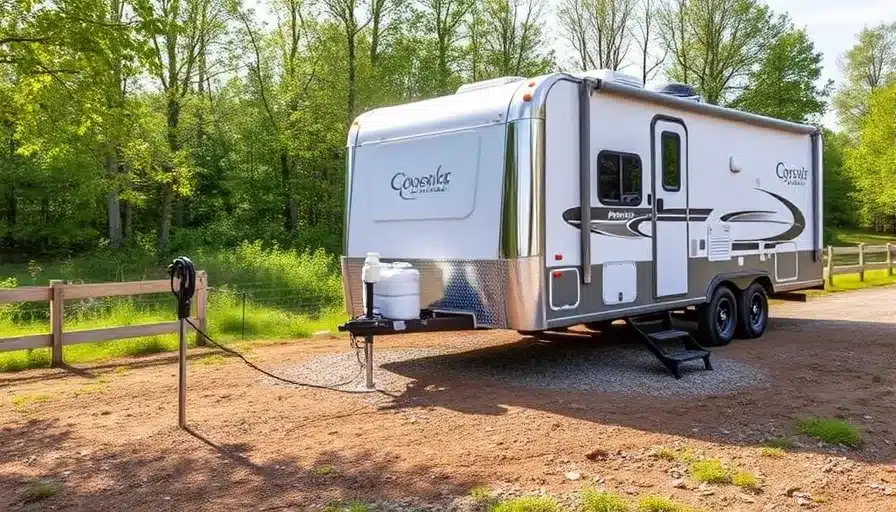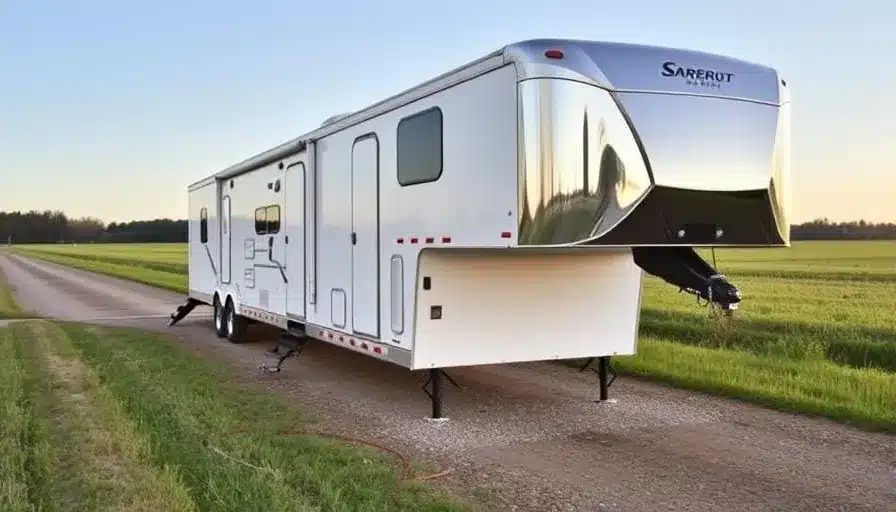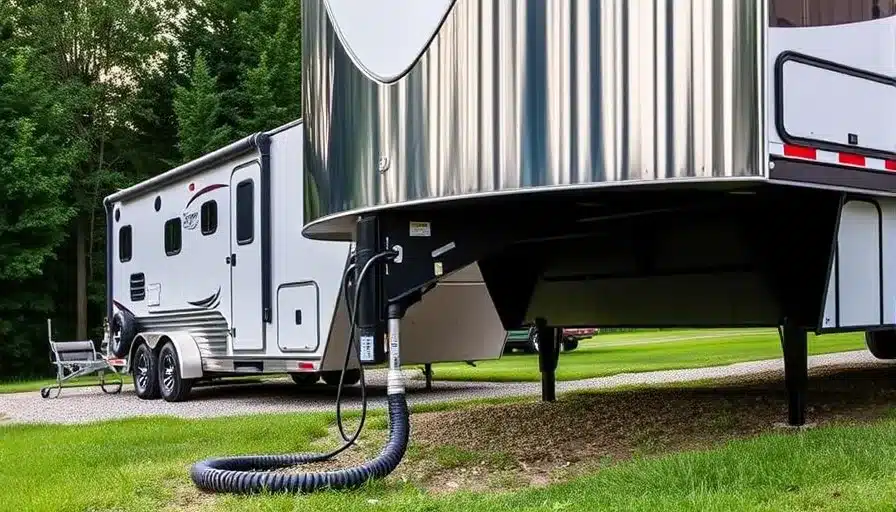When it comes to towing heavy loads, gooseneck trailers are often the top choice for many Americans. Known for their stability and ability to haul significant weight, they are a reliable option for everything from transporting livestock to heavy machinery. However, to ensure safety and efficiency, it’s crucial to hook up your gooseneck trailer correctly. This guide will walk you through the process, step-by-step, providing practical tips to help you get on the road with confidence. For those looking for top-quality gooseneck or custom trailers, look no further than Milltrailers. We offer a range of durable options designed to meet your specific needs.
Before diving into the hookup process, it’s essential to understand what makes a gooseneck trailer unique. A gooseneck trailer connects to a vehicle using a hitch mounted in the bed of a pickup truck, unlike bumper pull trailers that attach to the rear of the vehicle. The primary components include the gooseneck coupler, the trailer ball, and the safety chains. This setup provides better weight distribution over the truck’s rear axle, enhancing stability and allowing for a higher towing capacity compared to other trailer types.
Gooseneck trailers are particularly favored for heavy-duty tasks, such as hauling livestock, large equipment, or multiple vehicles. They offer superior maneuverability, especially on tight turns, and are less prone to swaying at high speeds. However, these benefits come with the need for precise alignment and secure attachment, making the proper hookup process crucial.
When choosing a gooseneck trailer, it’s vital to ensure it matches your towing vehicle’s capacity. The trailer ball size and weight capacity of your truck must be compatible with the trailer to prevent accidents and damage. For those needing a tailored solution, custom trailers from Milltrailers can be designed to meet specific hauling requirements, ensuring a perfect fit with your towing setup.
Before hooking up your gooseneck trailer, confirm that your towing vehicle is capable of handling the trailer’s weight. This involves checking both the Gross Vehicle Weight Rating (GVWR) of the trailer and the towing capacity of your truck. The trailer ball size is also crucial; it must match the gooseneck coupler on the trailer. Using an incorrect trailer ball can lead to an insecure connection, posing significant safety risks on the road.
Additionally, ensure that your truck bed is equipped with the proper gooseneck hitch system. If your vehicle doesn’t have one, a professional installation is recommended. Remember, the trailer’s weight should not exceed the towing vehicle’s capacity, as this can strain your vehicle’s engine, brakes, and transmission.
Before attempting to hook up the trailer, conduct a thorough inspection of both the trailer and the hitch system. Start by examining the trailer’s coupler to ensure it’s free of damage and wear. Next, check the trailer’s wiring, making sure all connections are intact, and there’s no fraying or corrosion. The tires should be inspected for proper inflation and tread depth; worn tires can lead to blowouts during transit.
The hitch itself should be closely inspected for any signs of rust or damage. Ensure that all moving parts, such as the locking mechanism, are functioning smoothly. The trailer’s brake system is another critical area; test it to ensure it’s responsive and in good working order. This inspection process is essential for preventing breakdowns and ensuring a safe journey.
Proper alignment of the towing vehicle and the gooseneck trailer is key to a successful hookup. Start by positioning your truck so that it’s directly in front of the trailer. Ideally, you’ll want the trailer and truck to be on level ground to make the alignment easier. Slowly back your truck towards the trailer until the trailer ball is directly beneath the gooseneck coupler. If you’re doing this alone, consider using a backup camera or mirrors to assist with alignment.
Take your time during this step—rushing can lead to misalignment, making the hookup process more difficult and increasing the risk of damage. Once aligned, double-check the positioning to ensure the coupler will lower directly onto the trailer ball.

Once your truck is properly aligned with the trailer, it’s time to lower the gooseneck coupler onto the trailer ball. Begin by raising the trailer’s front end using the jack stand until the coupler is high enough to clear the trailer ball. Slowly back the truck under the coupler, ensuring that the coupler aligns with the ball. Lower the trailer using the jack until the coupler rests securely on the ball.
At this point, it’s essential to check that the coupler is fully seated on the ball. Engage the locking mechanism to secure the coupler to the ball, and give the trailer a slight tug forward to test the connection. This tug test helps ensure that the coupler is locked in place and won’t come loose while driving.
Safety chains are a critical component of the trailer hookup process, providing an extra layer of security in case the coupler fails. Attach the safety chains to the designated hooks on your truck, crossing them underneath the coupler. The crossed chains create a cradle that can catch the trailer’s tongue if it disconnects from the ball, preventing the trailer from hitting the ground.
In addition to the safety chains, connect the breakaway cable to your truck. This cable is designed to activate the trailer’s brakes if the trailer becomes disconnected from the truck, helping to prevent accidents. Ensure the cable is attached in a way that it will pull free if the trailer separates, but not so taut that it could activate the brakes during normal driving.
The final step in hooking up your gooseneck trailer is connecting the trailer’s electrical system to the towing vehicle. This connection powers the trailer’s lights, brakes, and turn signals, all of which are vital for safe driving. Locate the trailer’s electrical plug and connect it to the corresponding socket on your truck.
After making the connection, test the trailer’s lights and brakes to ensure everything is functioning correctly. Turn on your vehicle’s headlights, brake lights, and turn signals, and walk around the trailer to check that all lights are working. Proper electrical connections are crucial, as they ensure you’re visible to other drivers and can signal your intentions on the road.

Before setting out on your journey, it’s crucial to conduct a final walk-around inspection to ensure all systems are functioning correctly. Start by testing the trailer’s lights. With your vehicle’s engine running, check the brake lights, turn signals, and running lights on the trailer. Make sure they are all operating in sync with your vehicle’s lights. Malfunctioning lights can lead to dangerous situations on the road, so it’s essential to address any issues before departure.
Next, test the trailer’s brake system. If your trailer is equipped with electric brakes, use the brake controller inside your vehicle to test them. Apply the brakes lightly and check if the trailer responds correctly. If you notice any delay or uneven braking, it may indicate an issue with the brake controller or the trailer’s braking system. This final check ensures that your trailer is road-ready and safe for travel.
Proper weight distribution is key to maintaining control and preventing trailer sway while driving. Before hitting the road, ensure that your trailer’s load is evenly distributed, with slightly more weight towards the front. This helps keep the trailer stable and reduces the risk of sway, which can be dangerous at high speeds. If your load isn’t balanced, take the time to redistribute the cargo, securing it with appropriate straps or ties. Ensuring proper weight distribution not only enhances safety but also improves the overall towing experience.
Even experienced drivers can make mistakes when hooking up a gooseneck trailer, so it’s important to be aware of common pitfalls and how to avoid them. One of the most frequent errors is neglecting to properly secure the safety chains. Failing to cross and attach them correctly can leave you vulnerable in the event of a coupler failure. Always ensure the chains are attached in an “X” pattern beneath the coupler.
Another common mistake is skipping the inspection of the trailer’s electrical connections. This can lead to issues with brake lights or turn signals, increasing the risk of accidents. Always test your trailer’s electrical system before driving.
Improperly aligning the trailer ball and coupler is another error to watch out for. This can result in a loose connection that may come apart during transit. Take your time to ensure perfect alignment before lowering the coupler onto the ball. By avoiding these mistakes, you can ensure a secure and safe hookup every time.
Hooking up a gooseneck trailer isn’t always smooth sailing, and you may encounter issues during the process. One common problem is the hitch not aligning correctly with the trailer ball. If this happens, try adjusting the height of the trailer or repositioning the truck slightly to achieve better alignment. Using a backup camera or a second person to guide you can also help.
Electrical problems, such as non-functioning lights or brakes, are another issue you might face. In such cases, check the connections for any loose wires or corrosion. Sometimes, simply unplugging and re-plugging the connector can resolve the issue.
If the trailer’s brakes aren’t responding correctly, it might indicate a problem with the brake controller in your vehicle. Refer to the controller’s manual for troubleshooting tips or consult a professional if the issue persists. Addressing these common problems promptly will ensure a smooth and safe towing experience.

Hooking up a gooseneck trailer may seem daunting at first, but by following these steps, you can ensure a secure and safe connection every time. From understanding the basics to conducting final safety checks, each step is crucial in preparing for a smooth journey. Whether you’re hauling livestock, equipment, or any other heavy load, taking the time to hook up your trailer properly is essential for your safety and that of others on the road.
For those in need of high-quality gooseneck or custom trailers, Milltrailers offers a wide range of options designed to meet your specific towing needs. Explore our selection today and find the perfect trailer to enhance your hauling experience. If you’re ready to take the next step in trailer ownership, contact Milltrailers to learn more about how we can help you with your trailer needs.
Click Here to Reach Out to Our Trailer Experts
Millennium Trailers is your trusted partner for high-quality trailers at unbeatable prices. Serving all 50 states, we’ve delivered over 5,000 trailers nationwide.
Established in 1998, we’re a company dedicated to meeting your hauling needs with excellence. Whether it’s cargo trailers or custom living quarters, we provide a wide range of options to suit your requirements. Our knowledgeable and friendly team ensures a smooth buying experience with personalized assistance. Proudly offering competitive pricing, state-of-the-art designs, and easy financing options. Committed to customer satisfaction, we strive to simplify the process of finding your perfect trailer.
Choose Millennium Trailers for a reliable, customized solution that delivers quality and value for your investment.
Copyright 1998 – 2023 Millennium Trailers, Inc.